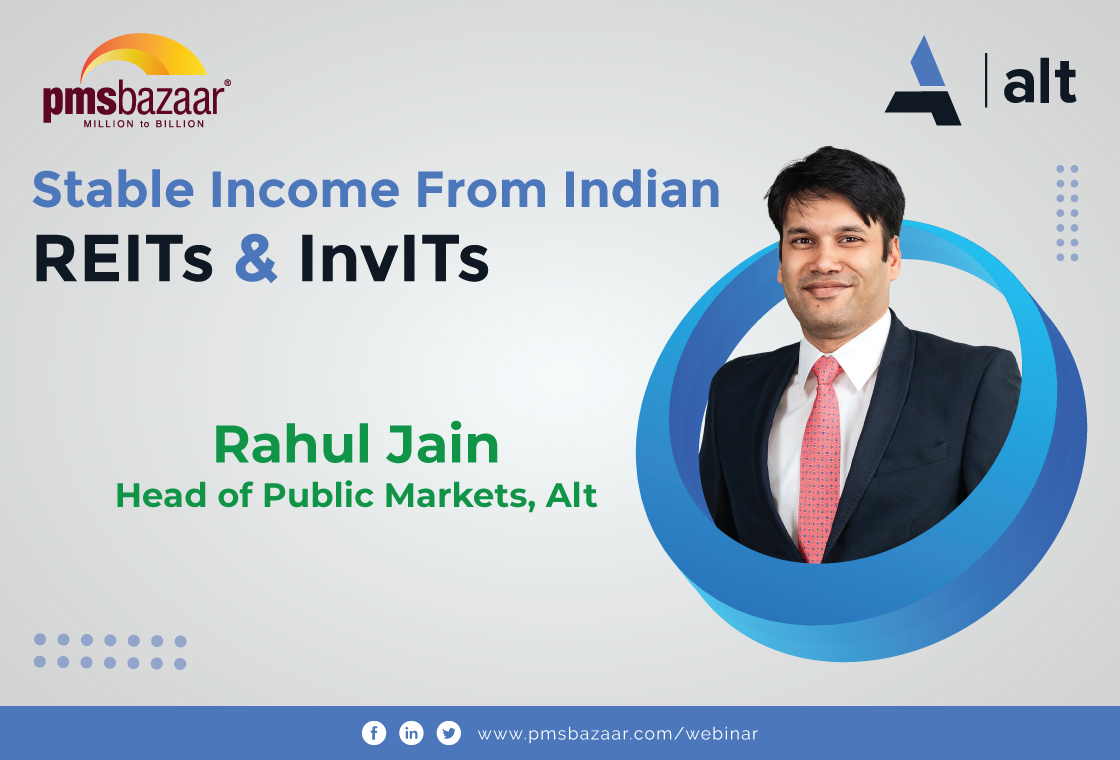PMS Bazaar recently organized a webinar titled “How to Invest When Markets Are at an All-Time High?,” which featured Nitin Agarwal, CEO, Torus Oro PMS. The webinar covered a wide range of topics, including insights on equity market investment, emphasizing the need to go beyond all-time market highs, consider valuation metrics, explore factor-based investing, and recognize opportunities in the infrastructure sector. It also delves into specific investment strategies like momentum and low-beta stocks.

Key aspects covered in this webinar blog are
- The valuation perspective
- Diving into individual stocks
- Taking a holistic approach
- The role of factor-based investing
- Factor performance over time
- Unveiling investment opportunities in the infrastructure sector
- Evolving investment strategies
Nitin Shah started by talking about whether investing in equity markets has become increasingly prevalent. With indices across the board, from large caps to small caps, reaching or approaching all-time highs, and key macroeconomic indicators like the market cap to GDP ratio soaring to historical levels, investors are pondering the wisdom of allocating funds in such an environment.
The Valuation Perspective: Looking Beyond All-Time Highs
According to Nitin Shah, “One fundamental reason for the growing apprehension is the surge in stock market indices. However, a deeper analysis reveals that looking at the indices alone might be misleading. To get a more accurate picture, it's essential to delve into valuations.”
Examining Price-to-Earnings (P/E) Ratios
P/E ratios, specifically on a trailing 12-month basis, are a classic metric to gauge the market's valuation. When we plot the P/E ratios for indices like Nifty 50 over the last five years, they might appear lower than expected when compared to the index's recent all-time high. However, this only provides part of the story.
The Forward-Looking Valuation
It's crucial to remember that trailing P/E ratios reflect the past. A more forward-looking approach might show even lower valuations, making the market seem more attractive for long-term investments.
Diving into Individual Stocks: Opportunities Amidst Overvaluation
While overall market valuations may be high, it's essential to recognize that these figures are averages across all stocks. Even in a seemingly overvalued market, some stocks remain undervalued. Thus, opportunities can be found by assessing individual companies rather than solely focusing on the market index.
The Possibility of PE Expansion
Historical examples, such as the prolonged PE expansion in the US during the 1980s and 1990s, remind us that high P/E ratios don't necessarily equate to poor investment choices. The market could continue to drive PE ratios even higher.
Taking a Holistic Approach: Weighing Multiple Factors
Nitin Shah stated, “Instead of relying solely on valuation metrics, it's crucial to evaluate various factors when making investment decisions. These factors include growth prospects, sector analysis, and historical market behaviour. A comprehensive approach ensures you consider all relevant aspects.”
The Role of Factor-Based Investing: A Paradigm Shift
Factor-based investing has gained traction since the financial crisis of 2008. It offers a novel perspective on portfolio diversification and risk management.
Unpacking Factor-Based Investing
Factor-based investing involves examining specific market factors, such as momentum, value, carry, and quality, to inform investment choices. For instance, you might choose to invest in stocks with momentum, like recently surging PSU stocks, or opt for value investments in sectors like private banks or IT. High-dividend stocks represent the carry factor while selecting quality companies like TCS embodies the quality factor.
The Catalyst: Norway Pension Fund
The popularity of factor-based investing surged after the Norway Pension Fund's unprecedented losses in 2008. Despite a diversified portfolio spread across geographies and market capitalizations, they realized they had not adequately managed risk. This led to the hiring of Professor Andrew Ang to analyze their approach.
Re-evaluating Diversification
Professor Ang's findings revealed that true diversification in equities goes beyond geography or market cap and involves considering different factors. He developed specific criteria for factors to be deemed valid and actionable.
Unpacking Factor-Based Investing for Improved Portfolio Performance
In the world of equity investing, one frequently encounters the term "factors." But what exactly are these factors, and why are they essential in shaping investment strategies?
Understanding the Properties of Investment Factors: Positive Expected Returns
One key attribute of an effective factor is that it should have a positive expected return in and of itself. For example, if you're implementing a value-based strategy, you should anticipate a positive return from your value investments. The same principle applies to other factor-based strategies like momentum.
Low Correlation
Factors should ideally have low correlations with each other. For instance, value and momentum factors often exhibit inverse relationships. When one performs well, the other may not. This low correlation helps diversify risk in a portfolio.
Fundamental Basis
Factors should be rooted in fundamental principles. A well-justified, data-driven foundation supports the credibility and effectiveness of factor-based investing.
Constructing a Diverse Portfolio
The idea of factor-based investing suggests that constructing a portfolio should involve exposure to various factors rather than relying solely on one. Large institutions often adopt this approach, recognizing its potential benefits.
Recognizing Existing Biases
Most individual investors already demonstrate some factor-based biases in their strategies, whether it's a penchant for value stocks, quality companies, or another factor. However, it's essential to understand that factors perform differently during various market conditions.
Factor Performance Over Time
Analyzing the performance of various factors over time is crucial. A historical perspective can help investors make informed decisions, especially in market conditions where one factor outperforms the others.
Factor Performance in India
A backtest analysis of different investment styles in the Indian market from 2013 to 2023 reveals some compelling insights. Notably, momentum emerged as one of the best-performing factors, with an impressive 18% annualized return. This data demonstrates the importance of diversifying across factors, as value underperformed in this scenario.
The Power of Momentum Investing
One specific factor, momentum, has proven to be a reliable and often overlooked component of factor-based investing.
Understanding Momentum
Momentum strategies capitalize on the short-term phenomenon where stocks that perform well continue to do so due to factors like benchmarking and retail investor influence.
Constructing a Momentum Strategy
Building a momentum strategy requires attention to nuances. Factors such as the choice of stocks, universe selection, time periods, and weighting methods play pivotal roles in creating an effective strategy.
Back testing Momentum
A back test of a momentum strategy since 2015 demonstrates its potential. The strategy delivered a compound annual growth rate (CAGR) of 20%, surpassing the Nifty 50's performance. Additionally, the strategy's Sharpe ratio indicates superior risk-adjusted returns.
Real-World Success
The momentum strategy isn't just theoretical; it's being implemented successfully in a Portfolio Management Services (PMS) fund. Investors have experienced significant returns, with a 33.9% gain over the past six months.
Portfolio Enhancement Through Factor Diversification
The momentum strategy's performance, when combined with traditional value and quality portfolios, demonstrates the advantages of diversifying across factors. This approach reduces correlation and enhances returns.
Expanding Horizons
Diversifying across factors within your equity portfolio can substantially improve its performance. Factor diversification is especially critical when markets reach all-time highs.
Embracing Factor-Based Investing
Factor-based investing can help investors capitalize on different market conditions. Understanding the dynamic nature of factors and their performance can lead to more informed investment choices.
Factor-based investing is a comprehensive approach to navigating the equity markets, providing investors with tools to make informed decisions even when the market is at all-time highs. It's a strategy grounded in data, supported by historical performance, and capable of delivering enhanced returns while reducing risk. By expanding their perspective and incorporating diverse factors into their portfolios, investors can better position themselves for success in the dynamic world of equity investments.
Unveiling Investment Opportunities in the Infrastructure Sector
According to Nitin Shah, “In the dynamic world of investment, staying ahead of the curve means identifying sectors with promising growth potential. One such sector that has been making waves in India is infrastructure.”
Government-Led Growth
Over the past few years, the Indian government has embarked on an ambitious journey to bolster the nation's infrastructure. This sustained effort is poised to drive economic growth, making infrastructure a pivotal element in India's development story.
Addressing Bottlenecks
Infrastructure encompasses various segments, from logistics to highways and railways. Tackling bottlenecks in these areas is crucial to fueling economic growth. The government's increased capital expenditure (CAPEX) is a testament to its commitment to overcoming these challenges.
Selective Investment
While the infrastructure sector holds great promise, it's not without its risks. The sector's performance is often company-specific and reliant on the credibility and capabilities of the players involved. Discerning investors should focus on collaborating with established, reliable companies with a track record of success.
Evolving Investment Strategies
In a discussion with financial experts, a common question arises: What investment strategies should one pursue in the ever-changing market landscape? Some of the strategies employed by experienced investors are as follows.
Factor-Based Investing
Factor-based investing is a method that considers various factors to construct a diverse portfolio. This approach includes analyzing the market, evaluating the right players, and identifying the best market opportunities.
Momentum Investing
One underappreciated factor in factor-based investing is momentum. Understanding the principles of momentum investing and leveraging them can lead to outperforming the market. Momentum investing is driven by short-term phenomena, where stocks that perform well tend to continue their upward trajectory.
Understanding Low Beta Stocks
Low-beta stocks are another aspect of factor-based investing that has gained attention. They often deliver excess returns compared to the Capital Asset Pricing Model (CAPM).
Leverage in the Market
The reason low-beta stocks provide excess returns is connected to market dynamics and leverage. Some investors have the capacity to take on leverage, while others are restricted to long-only positions. As a result, low-beta stocks are often overlooked by long-only investors, creating an anomaly in the market.
Transaction Costs
Rebalancing a portfolio is crucial, but it's essential to strike a balance between the frequency of rebalancing and transaction costs. While daily rebalancing is theoretically optimal, it is often more practical to rebalance portfolios on a quarterly basis to manage costs efficiently.
Agility and Alpha Generation
Smaller PMS managers offer agility that larger players may lack. They can swiftly adapt to market dynamics, make timely decisions, and generate alpha for investors.
Nitin Shah covered all the topics mentioned above in-depth and answered questions from the audience toward the end of the session. For more such insights on this webinar, watch the recording of this insightful session through the appended link below:
Get access to rich data and analytics of PMS & AIF by subscribing to us. Join the 55000+ investors & experts now: Subscribe NOW
Recent Blogs
.jpg)
Passively Active Investing — A Modern Investor’s Lens on ETF-Based PMS
PMS Bazaar recently organized a webinar titled “Passively Active Investing — A Modern Investor’s Lens on ETF-Based PMS,” which featured Mr. Karan Bhatia, Co-Founder and Co-Fund Manager , Pricebridge Honeycomb ETF PMs. This blog covers the important points shared in this insightful webinar.

Spot the Trouble: Red Flags in Equity Investment Analysis
PMS Bazaar recently organized a webinar titled “Spot the Trouble: Red Flags in Equity Investment Analysis,” which featured Mr. Arpit Shah, Co-Founder & Director, Care Portfolio Managers. This blog covers the important points shared in this insightful webinar.

Long-Only AIFs Rebound Sharply in October; Long-Short Strategies Lag Despite Lower Volatility
106 long-only AIFs averaged 3.68% vs 32 long-short AIFs at 2.7%; only 24–31% of funds beat key indices

Markets log strongest monthly gains in 7 months; PMS performance turns near-uniform in October
Nifty 50 TRI gained 4.62%, BSE 500 TRI rose 4.27%; 415 of 427 equity PMSes ended positive

How SMEs are Shaping India’s Investment Landscape?
PMS Bazaar recently organized a webinar titled “How SMEs are Shaping India’s Investment Landscape?” which featured Mr. Shrikant Goyal, Fund Manager, GetFive Opportunity Fund.

Stable Income from Indian REITs and InvITs
PMS Bazaar recently organized a webinar titled “Stable Income from Indian REITs and InvITs,” which featured Mr. Rahul Jain, Head of Public Markets, Alt.

5 Key Considerations Before Investing in AIFs in India
Alternative Investment Funds (AIFs) have emerged as a compelling option for sophisticated investors seeking diversification and potentially superior returns. But venturing into AIFs requires a clear understanding of their unique characteristics that go beyond simply knowing what they are and their categories.

How AIF can help in diversification?
Traditionally, Indian investors have relied on a mix of stocks and bonds to build their wealth. While this approach offers diversification, it can still leave your portfolio vulnerable to market fluctuations. Enter Alternative Investment Funds (AIFs), a dynamic asset class gaining traction for its ability to unlock diversification beyond the realm of conventional options.

